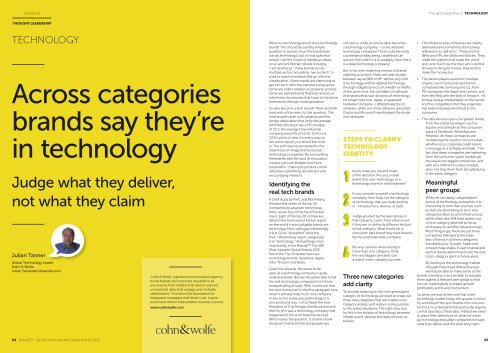Create successful ePaper yourself
Turn your PDF publications into a flip-book with our unique Google optimized e-Paper software.
Section 03<br />
Thought Leadership // TECHNOLOGY<br />
THOUGHT LEADERSHIP<br />
TECHNOLOGY<br />
Across categories<br />
brands say they’re<br />
in technology<br />
Judge what they deliver,<br />
not what they claim<br />
Julian Tanner<br />
Global Technology Leader<br />
Cohn & Wolfe<br />
Julian.Tanner@cohnwolfe.com<br />
Cohn & Wolfe, a global communications agency,<br />
builds brands and corporate reputations by<br />
uncovering fresh insights that lead to relevant,<br />
unexpected ideas that engage and motivate<br />
stakeholders. This forms the foundation for<br />
integrated campaigns that foster trust, inspire<br />
action and deliver measureable business success.<br />
www.cohnwolfe.com<br />
When is a technology brand not a technology<br />
brand? This should be a pretty simple<br />
question to answer (clue: the brand does<br />
not do technology), but it’s not quite that<br />
simple. Like the crowd of rebellious slaves<br />
on an ancient Roman hillside shouting,<br />
“I am Spartacus,” many brands across<br />
multiple sectors are yelling, “we are tech” in<br />
a bid to reap the rewards that go with the<br />
classification. Some brands are clamoring to<br />
get into tech from the manufacturing sector,<br />
some are online retailers or property services,<br />
some are old fashioned financial services or<br />
information businesses that hope to transform<br />
themselves through recategorization.<br />
So why become a tech brand? There are both<br />
hard and soft answers to that question. The<br />
hard answers start with valuation and the<br />
simple observation that while the average<br />
NASDAQ 100 stock has a P/E multiple<br />
of 25.2, the average Dow Industrial<br />
company has a P/E of 16.55. So from a<br />
CEO’s point of view it is pretty easy to<br />
see which sector you would like to be<br />
in. The soft reasons are related to the<br />
cleanliness of image that surrounds<br />
technology companies. By surrounding<br />
themselves with the aura of innovation,<br />
a brand can look sharper and more<br />
purposeful - making its products more<br />
attractive, benefitting recruitment and<br />
encouraging investors.<br />
Identifying the<br />
real tech brands<br />
A 2014 study by PwC and Bloomberg<br />
showed that seven of the top 10<br />
companies by value are technology<br />
firms, as are four of the top 10 fastest<br />
risers. Eight of the top 20 companies<br />
listed in the most recent Forbes report<br />
on the world’s most valuable brands are<br />
technology firms, although interestingly<br />
it lists GE as “diversified” while the<br />
PwC / Bloomberg report categorizes<br />
it as “technology.” And perhaps most<br />
importantly, in the BrandZ Top 100<br />
Most Valuable Global Brands 2015,<br />
five of the Top 10 fastest risers are<br />
technology brands: Facebook, Apple,<br />
Intel, Tencent and Baidu.<br />
Given the rewards, the desire to be<br />
seen as a technology company is quite<br />
understandable. But we should be able to tell<br />
the real technology companies from those<br />
masquerading as such. Well, it turns out that<br />
the clue mentioned in the first paragraph here<br />
doesn’t actually help much. Any company<br />
in any sector today uses technology in a<br />
very profound way. I once heard the Vice<br />
President of IT at Morgan Stanley pronounce<br />
that his firm was a technology company that<br />
happened to focus on financial services.<br />
Which raises the question: is a bank a bank<br />
because it has branches and people you<br />
can talk to, while an online bank becomes<br />
a technology company – or are all banks<br />
technology companies? And could we really<br />
countenance eBay being classified as an<br />
auction firm when it is so palpably clear that it<br />
is a deep technology company?<br />
But in this ever-widening morass of brands<br />
claiming to be tech, there are clear divides<br />
between say an IBM or HP, whose very core<br />
is technology and the applied technology<br />
through a digital service of LinkedIn or Netflix.<br />
At the same time, the old labels of software<br />
and hardware as sub-divisions of technology<br />
no longer hold true; Apple, a supposed<br />
hardware company, is differentiated by its<br />
software, while one-time software specialists<br />
Oracle and Microsoft have bridged the divide<br />
into hardware.<br />
Three new categories<br />
add clarity<br />
To provide meaning to the over-generalized<br />
category of technology we need to break out<br />
three new categories that will enable crosscategory<br />
analysis and restore some purpose<br />
to the brand valuations. The right structure<br />
for this is the division of technology between<br />
infrastructure, devices and data services, as<br />
follows:<br />
• The infrastructure companies are clearly<br />
delineated and sometimes dismissively<br />
referred to as “old tech.” These are the<br />
IBMs and HPs, the Dells and Oracles. They<br />
make the systems that make the world<br />
spin, and much like the men who sold the<br />
shovels to the gold miners, they tend to<br />
make the money too.<br />
• The device players arise from multiple<br />
origins; out of consumer electronics<br />
companies like Samsung and LG, from<br />
PC companies like Apple and Lenovo, and<br />
from left field with the likes of Amazon. All<br />
bring a unique interpretation to this sector<br />
and the competition that they engender<br />
has been massively beneficial to the<br />
consumer.<br />
• The data services span a far greater divide,<br />
from the enterprise players such as<br />
Equifax and LinkedIn to the consumer<br />
plays of Facebook, WhatsApp and<br />
Pinterest. All these companies are<br />
monetizing the need to consume data<br />
whether it is a corporate credit report,<br />
a message or a birthday reminder. The<br />
fact that these companies are marketing<br />
from the consumer youth markets all<br />
the way to the biggest enterprises, and<br />
with very different business models,<br />
does not stop them from actually being<br />
in the same category.<br />
Meaningful<br />
peer groups<br />
While we can apply categorization<br />
across all technology companies, it is<br />
interesting to note that very few, such<br />
as Dell, are attempting to be in two<br />
categories (devices and infrastructure),<br />
while others like IBM have gotten out<br />
of one category (devices) to focus<br />
exclusively on another (infrastructure).<br />
Most intriguingly, there are just three<br />
companies attempting the tripleplay<br />
of being in all three categories<br />
simultaneously; Google, Apple and<br />
Amazon have stakes in each market and<br />
each is clearly determined to be the one<br />
cross-category giant in future years.<br />
By looking at the technology market<br />
through these three different lenses<br />
we may be able to make sense of the<br />
brands crowding in and be able to evaluate<br />
them against a relevant peer group so that<br />
we can meaningfully compare growth,<br />
profitability and brand momentum.<br />
So when we look at the mire that is the<br />
technology market today, the answer is not to<br />
try and discern the tech brands from the nontech<br />
but to understand that practically anyone<br />
can be Spartacus these days. Instead we need<br />
to place finer definitions on what we mean<br />
by technology and judge companies through<br />
what they deliver and not what they claim.<br />
54 BrandZ Top 100 Most Valuable Global Brands 2015<br />
55




